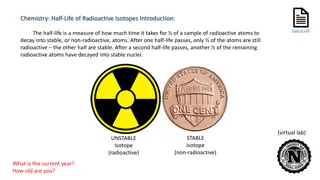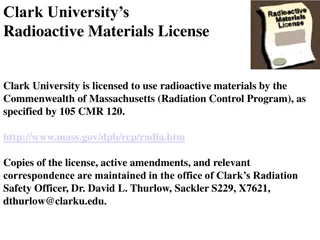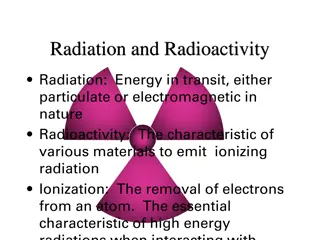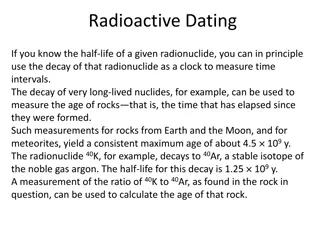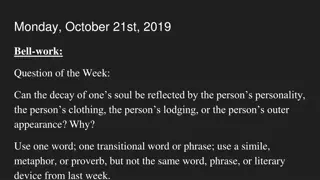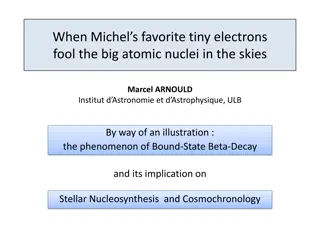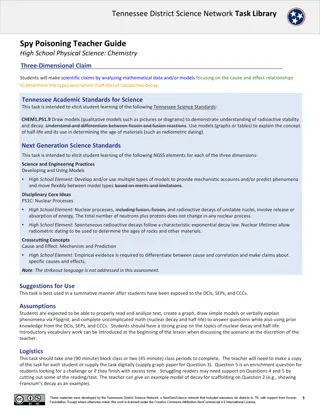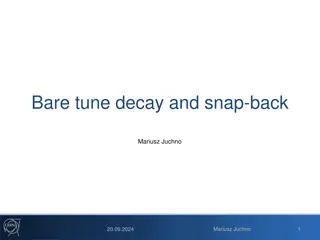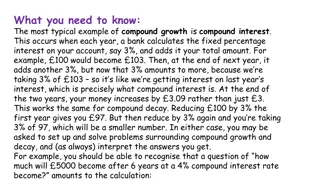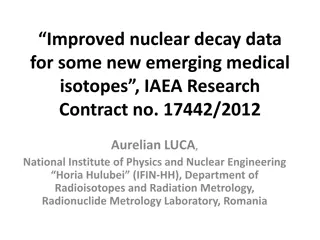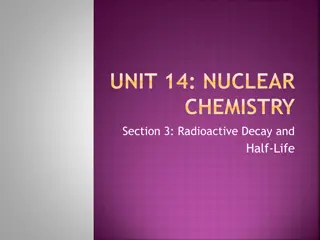GAMIFY Session - Explore Isotopes, Decay, and Critical Path Game
Dive into the world of isotopes, decay processes, and the Critical Path Game in this engaging session from the 2017 Duke Energy NAYGN Chapter Conference. Discover the significance of the periodic table of elements, learn about different isotopes, and understand concepts like half-life and fission. Explore alpha and gamma decay, beta decay, and the concept of nuclides. Get ready to play the Critical Path Game where players journey from Uranium-235 to Lead-207.
Download Presentation

Please find below an Image/Link to download the presentation.
The content on the website is provided AS IS for your information and personal use only. It may not be sold, licensed, or shared on other websites without obtaining consent from the author. Download presentation by click this link. If you encounter any issues during the download, it is possible that the publisher has removed the file from their server.
E N D
Presentation Transcript
GAMIFY Session 2017 Duke Energy NAYGN Chapter Conference 6/08/17
Overview Review Periodic table of elements Isotopes Decay Half-life Chart of Nuclides Learn how to play CRITICAL PATH Game on!
Periodic Table of Elements https://www.classzone.com/books/earth_science/terc/ content/investigations/es0501/es0501page06.cfm
Isotopes The atomic number (or number of protons) defines the element Elements have various isotopes which differ in their number of neutrons Nuclide is another term used to define isotopes when speaking specifically about the nucleus Radioactive isotopes have an unstable nucleus and decay until stability is reached http://nuclearconnect.org/know-nuclear/science/isotopes
Fission http://matterchatter.files.wordpress.com/2011/03/nuclear.jpg 235? 236? 1? + 0 92 92
Alpha and Gamma Decay Alpha Decay Nucleus emits an alpha particle (helium nucleus) 92 Gamma decay 60?? 28 60?? + 1 0? + 20 0? 235? 2 231? 4? + 90 27 http://www.physics.isu.edu/radinf/rads&rads.htm
Beta Decay Beta Decay Positron Emission 15? 7 0? 40? 20 97?? + 1 0? 15? + +1 8 19 http://www.physics.isu.edu/radinf/rads&rads.htm
Half-life All nuclides have a particular half life ranging from very long to very short http://www.physics.isu.edu/radinf/rads&rads.htm
Critical Path Objective: All players start as an atom of Uranium-235 on the chart of nuclides The player who reaches Lead-207 first wins! http://metadata.berkeley.edu/nuclear-forensics/Decay%20Chains.html
Critical Path Components - Board Game board is a segment of the chart of nuclides colored based on each isotope s half-life
Critical Path Components - Cards 5 types each player starts with 4 cards Used to move yourself OR your opponents on the game board
Critical Path Components - Dice Each player gets one white D6 dice The remaining dice are colored for the type listed below Note the color of the dice corresponds to the color of the cards To be used during Alpha Decay Neutron Absorption, Neutron Emission, or spontaneous decay Type Number included 5 Color Red Four-sided (D4) Six-sided (D6) 15 White Beta or Beta- Positron Emission Wild card Eight-sided (D8) 5 Blue Ten-sided (D10) 5 Green
Critical Path Round Summary during each player s turn, they may choose one of these two actions: 1. Draw two cards Draw top two cards from the decay card draw pile Maximum of 10 cards in hand at a time if you go over 10 cards, discard down to 10 2. Play cards Play as many cards as you please Collect corresponding dice to the cards being played one dice per card Declare if you are using the decay cards on yourself (defend) or another player (attack): 1. Defend: The player gets one guaranteed card to move of their choice For the remaining cards played, the decay is successful if the dice result is greater than or equal to 3. 2. Attack: The decay is successful if the dice result is greater than or equal to 4
Critical Path Round Summary (continued) Half-life resolution: After each player has played their turn, every player spontaneously decays Look at isotope occupied by your piece and determine the successful spontaneous decay roll from the isotope half-life legend Roll your white six sided dice. If the result is greater than or equal to the number in the legend, the spontaneous decay occurs move player disc equal to the half-life legend number in any direction
Critical Path Special Rules: R&D Required if a player lands on an undiscovered isotope then they lose a turn to research the element! Once landing on the space, place the R&D cone on the player piece to signify you are losing your next turn
Critical Path Example 1: Emily is on the starting point of U-235 and decides it s a little crowded so she is going to move. She declares: I am outta here, so I am playing for myself and lays the following cards:
Critical Path Example 1 (continued) Emily decides, since she likes the wild card so much, that she will choose that as her guaranteed move, and will not need to roll for it She then rolls the remaining four dice, trying to get a 3 or above
Critical Path Example 1 (continued) Emily rolls the following, and gets to move her player corresponding to the successes 1 5 2 4
Critical Path Example 1 (continued) Now that everyone in the group has played their turn, it is the spontaneous decay phase At the end of her last turn, Emily landed on Ac-228 which has a half life of > 1 hr Emily must roll a 4 or higher in order to spontaneously decay! She rolls her white D6 dice shouting Big Money Big Money!!! and rolls .. A 5! Therefore lucky Emily gets to move 4 additional spaces in any chosen direction
Critical Path Example 2 (continued) Emily realizes that Jason is about to win the game since he is only two spaces away from Pb-207, on Pb-209! She decides to attack by saying: I m going to play this turn for Jason! and lays the following cards:
Critical Path Example 2 (continued) Since this is an attack play, Emily must roll all dice, and get a 4 or higher for a successful decay 3 1 8 6 5
Critical Path Example 2 (continued) Emily realizes that her beta decay and positron emission cards cancel each other out! But she can still use her wild to move him 2 spaces to Bi-209 Since Bi-209 is STABLE, Jason will not be able to spontaneously decay!
Critical Path Questions Can I play a card even though it would make me go off the table? NO you can only use cards that move you to a position that is on the board What if 2 people reach Pb-207 after decaying? There will be a roll-off to determine the winner Can I attack two people at once? Or play some cards for myself and others for them? No, all cards being played are for only one person at a time
Critical Path Special thanks to everyone who came up with the game concept and helped us with our beta testing run through (listed) and the many volunteers helping facilitate! Emily Young Kyle Hemker Ben Horstman Jason Young Alyse Scurlock Ryan Trogstad Nathan Huffman Enjoy the game!!!

 undefined
undefined







